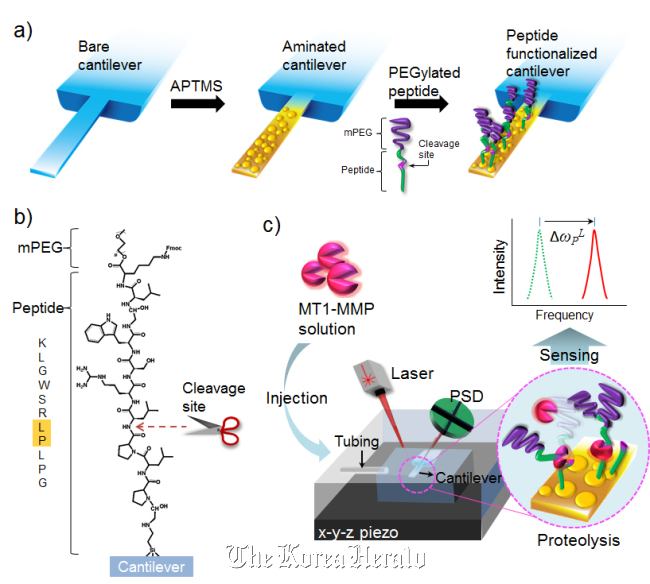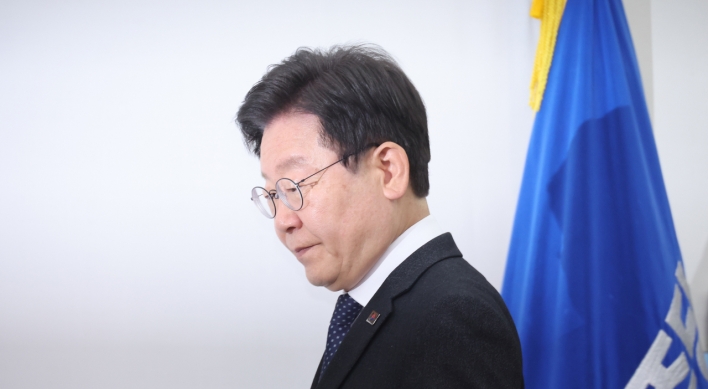Scientists find new method for early cancer diagnosis
By Korea HeraldPublished : June 19, 2012 - 20:09
Researchers from Yonsei University have found a new method of detecting tumor cells in early stages, claiming a critical advance in cancer diagnosis.
Early detection is the key to the treatment of cancer. Doctors currently have to go through a series of medical tests and examine the removed tissues under a microscope to find cancerous cells.

Instead of the traditional time-consuming method, the Korean research team used a high-resolution microscope to detect a specific type of protein called matrix metalloprotease, or MMPs, that is believed to play a pivotal role in cancer-cell growth and spread.
The new method could save time and costs for cancer detection, according to Yoon Dae-sung, professor of biomedical engineering at the university.
In their study, Yoon and his co-researchers used the Atomic Force Microscope that is used for high resolution imaging of atomic scale structures in order to examine matrix metalloproteases,
The research team attached chains of amino acids that are specifically cleaved by MMPs to a tiny “cantilever,” and exposed it to MMPs. They found that this exposure led to a decrease in the mass of the cantilever, indicating that the MMPs had cut the amino acid chains.
This means that using the atomic microscope, they may be able to monitor the peptide cleavage reaction, and use it to detect the presence of MMPs, and therefore cancer.
The AFM is already commercially used in measuring and manipulating at the micro scale, according to Yoon.
“But our study is one of the first to detect cancer cells using the atomic microscope,” he said, noting that the method can be a cost-effective alternative to other contemporary methods for detecting MMP activity.
He, however, admitted that the study used genetically engineered cell samples, and they need further experiments with more realistic samples in different stages of cancer development for further development.
“We still need rigorous clinical tests, so it might take at least three to four years before doctors could actually adopt our method,” he added.
The study, supported by the Ministry of Education, Science and Technology and National Research Foundation of Korea, was published in the international edition of Angewandte Chemie, a weekly peer-reviewed scientific journal, on June 11.
By Oh Kyu-wook (596story@heraldcorp.com)
Early detection is the key to the treatment of cancer. Doctors currently have to go through a series of medical tests and examine the removed tissues under a microscope to find cancerous cells.

Instead of the traditional time-consuming method, the Korean research team used a high-resolution microscope to detect a specific type of protein called matrix metalloprotease, or MMPs, that is believed to play a pivotal role in cancer-cell growth and spread.
The new method could save time and costs for cancer detection, according to Yoon Dae-sung, professor of biomedical engineering at the university.
In their study, Yoon and his co-researchers used the Atomic Force Microscope that is used for high resolution imaging of atomic scale structures in order to examine matrix metalloproteases,
The research team attached chains of amino acids that are specifically cleaved by MMPs to a tiny “cantilever,” and exposed it to MMPs. They found that this exposure led to a decrease in the mass of the cantilever, indicating that the MMPs had cut the amino acid chains.
This means that using the atomic microscope, they may be able to monitor the peptide cleavage reaction, and use it to detect the presence of MMPs, and therefore cancer.
The AFM is already commercially used in measuring and manipulating at the micro scale, according to Yoon.
“But our study is one of the first to detect cancer cells using the atomic microscope,” he said, noting that the method can be a cost-effective alternative to other contemporary methods for detecting MMP activity.
He, however, admitted that the study used genetically engineered cell samples, and they need further experiments with more realistic samples in different stages of cancer development for further development.
“We still need rigorous clinical tests, so it might take at least three to four years before doctors could actually adopt our method,” he added.
The study, supported by the Ministry of Education, Science and Technology and National Research Foundation of Korea, was published in the international edition of Angewandte Chemie, a weekly peer-reviewed scientific journal, on June 11.
By Oh Kyu-wook (596story@heraldcorp.com)
-
Articles by Korea Herald





![[Herald Interview] 'Amid aging population, Korea to invite more young professionals from overseas'](http://res.heraldm.com/phpwas/restmb_idxmake.php?idx=644&simg=/content/image/2024/04/24/20240424050844_0.jpg&u=20240424200058)












![[KH Explains] Korean shipbuilding stocks rally: Real growth or bubble?](http://res.heraldm.com/phpwas/restmb_idxmake.php?idx=652&simg=/content/image/2024/04/25/20240425050656_0.jpg&u=)

